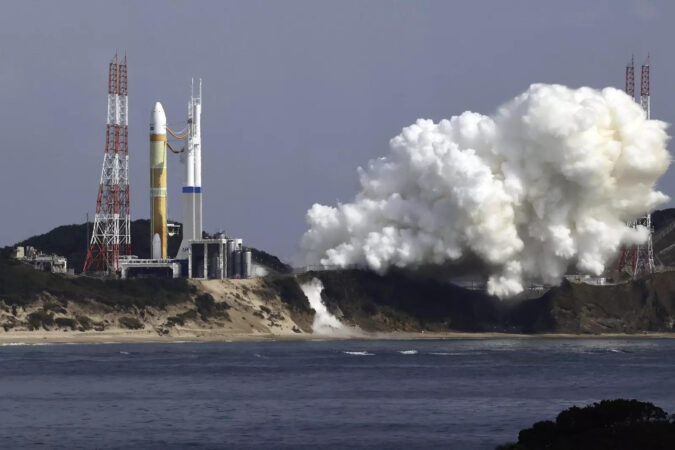Japan’s much-vaunted launch of its flagship rocket was a fizzer — a disappointing result as competition with Elon Musk’s SpaceX intensifies and the island nation looks to expand its defense prowess amid growing geopolitical tensions.
While weather conditions were good, the H3 rocket’s side booster failed to ignite, officials said Friday morning. Sparks flew from the craft as it prepared to take off, but within seconds they spluttered to a halt.
“It’s expected that it will take longer to examine the situation,” JAXA, or the Japan Aerospace Exploration Agency, said during a live broadcast after the launch was aborted.
Mitsubishi Heavy Industries Ltd. spent almost a decade designing and building the H3, a 63-meter-high rocket it says offers a cheaper, more reliable alternative to competitors. Musk’s Space Exploration Technologies Corp. is developing a rocket that can be landed and reused, while the H3 can not.
The H3 was supposed to make its inaugural launch on Friday morning from the Tanegashima Space Center, in southwestern Japan, using an explosive 267 tons of vertical force to escape the grip of Earth’s gravitational pull and deliver a satellite known as DAICHI-3 into orbit.
The launch was originally scheduled to happen five days earlier but was postponed twice due to inclement weather. The rocket was also supposed to be introduced late last year but its unveiling was delayed twice due to issues with the main engine, according to JAXA.
The satellite mounted on the rocket is equipped with a multitude of instruments, one of which is a sensor designed to detect missile launches that’s being tested in space for the first time by the Japanese defense ministry.
The H3 replaced the H2-A, which was first introduced in 2001, as the country’s flagship rocket.
As nations race to claim their slice of a growing aerospace market, JAXA said it aims to launch six satellites into space a year for the next 20 years.
For a long time, the main issue was price. At about $90 million a launch, the H2-A had a similar payload capacity but came at a greater price than the Falcon 9 booster from SpaceX, which costs $67 million per launch. According to JAXA, launching the H3 once costs $50 million.
While rockets with large payload capacities account for a fraction of the global space economy, the commercial satellite industry generated $386 billion in 2021 and continues to grow, according to data from the Satellite Industry Association.
While weather conditions were good, the H3 rocket’s side booster failed to ignite, officials said Friday morning. Sparks flew from the craft as it prepared to take off, but within seconds they spluttered to a halt.
“It’s expected that it will take longer to examine the situation,” JAXA, or the Japan Aerospace Exploration Agency, said during a live broadcast after the launch was aborted.
Mitsubishi Heavy Industries Ltd. spent almost a decade designing and building the H3, a 63-meter-high rocket it says offers a cheaper, more reliable alternative to competitors. Musk’s Space Exploration Technologies Corp. is developing a rocket that can be landed and reused, while the H3 can not.
The H3 was supposed to make its inaugural launch on Friday morning from the Tanegashima Space Center, in southwestern Japan, using an explosive 267 tons of vertical force to escape the grip of Earth’s gravitational pull and deliver a satellite known as DAICHI-3 into orbit.
The launch was originally scheduled to happen five days earlier but was postponed twice due to inclement weather. The rocket was also supposed to be introduced late last year but its unveiling was delayed twice due to issues with the main engine, according to JAXA.
The satellite mounted on the rocket is equipped with a multitude of instruments, one of which is a sensor designed to detect missile launches that’s being tested in space for the first time by the Japanese defense ministry.
The H3 replaced the H2-A, which was first introduced in 2001, as the country’s flagship rocket.
As nations race to claim their slice of a growing aerospace market, JAXA said it aims to launch six satellites into space a year for the next 20 years.
For a long time, the main issue was price. At about $90 million a launch, the H2-A had a similar payload capacity but came at a greater price than the Falcon 9 booster from SpaceX, which costs $67 million per launch. According to JAXA, launching the H3 once costs $50 million.
While rockets with large payload capacities account for a fraction of the global space economy, the commercial satellite industry generated $386 billion in 2021 and continues to grow, according to data from the Satellite Industry Association.
